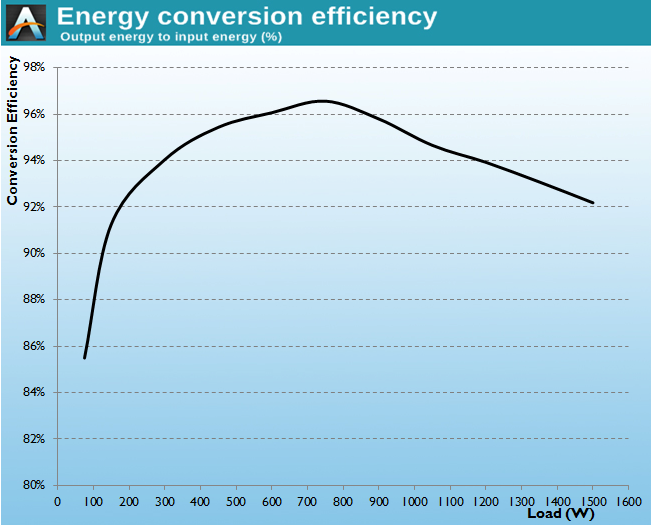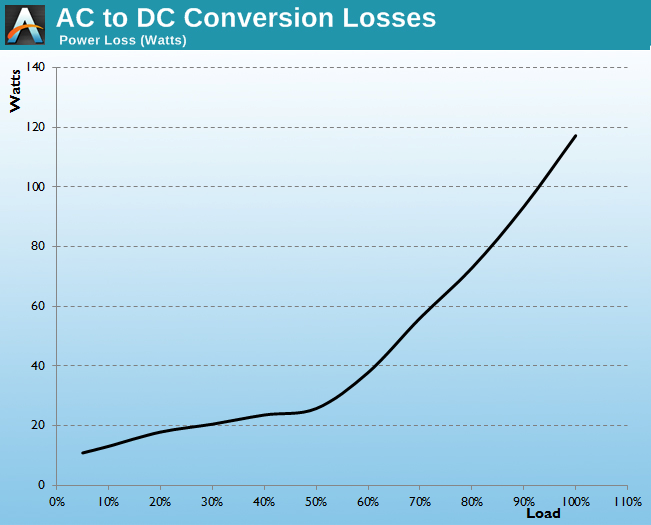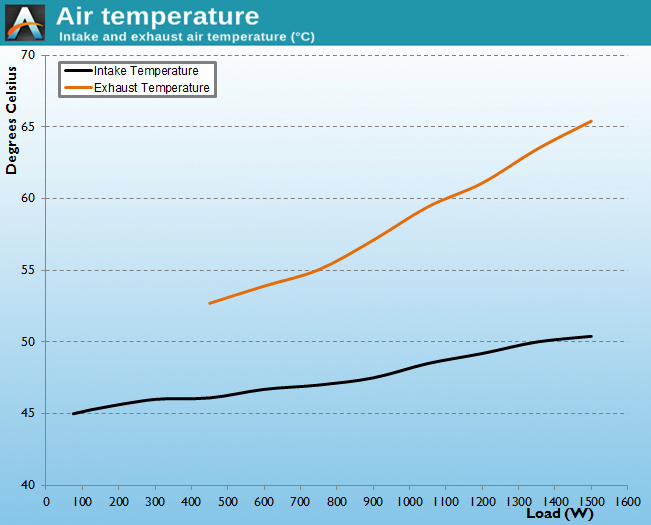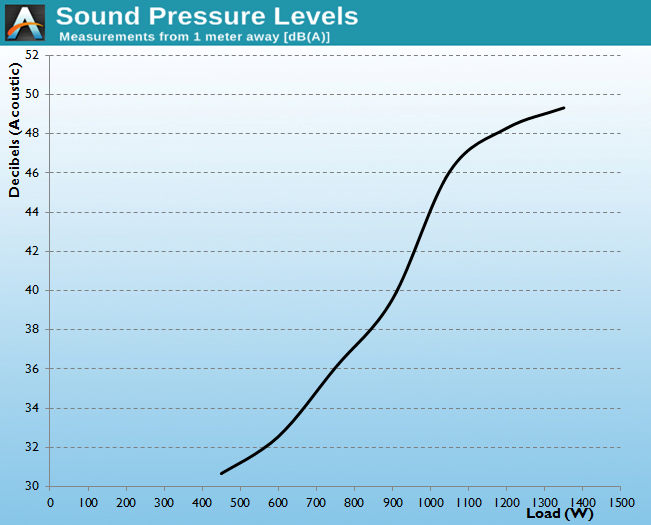Corsair AX1500i Power Supply Review
by E. Fylladitakis on September 11, 2014 5:00 AM EST- Posted in
- Cases/Cooling/PSUs
- Corsair
- PSUs
- 1500W
Hot Test Results
From the tables below, we can see that the output power quality of the Corsair AX1500i is simply setting new performance records. Our instrumentation recorded a maximum ripple of just 16mV on the 12V line under maximum load, while drawing 107.2 Amperes from it! Cross loading the voltage lines had virtually zero effect on the stability of the unit, courtesy of the dual LLC PSU design we mentioned in the Internal Design section. Finally, the voltage regulation is remarkable, with the worst and best results being 0.5% and a mere 0.15% on the 5V and 12V lines, respectively!
| Main Output | ||||||||
| Load (Watts) | 300.98 W | 751.78 W | 1126.37 W | 1501.55 W | ||||
| Load (Percent) | 20.07% | 50.12% | 75.09% | 100.1% | ||||
| Line | Amperes | Volts | Amperes | Volts | Amperes | Volts | Amperes | Volts |
| 3.3 V | 5.15 | 3.34 | 12.86 | 3.34 | 19.3 | 3.33 | 25.73 | 3.33 |
| 5 V | 5.15 | 5.02 | 12.86 | 5.02 | 19.3 | 5 | 25.73 | 4.99 |
| 12 V | 21.44 | 12.03 | 53.6 | 12.02 | 80.4 | 12.01 | 107.2 | 12.01 |
| Line |
Regulation (20% to 100% load) |
Voltage Ripple (mV) | |||||
| 20% Load | 50% Load | 75% Load | 100% Load |
CL1 12V |
CL2 3.3V + 5V |
||
| 3.3V | 0.4% | 6 | 10 | 12 | 12 | 4 | 8 |
| 5V | 0.5% | 4 | 6 | 10 | 12 | 6 | 10 |
| 12V | 0.15% | 6 | 8 | 12 | 16 | 14 | 6 |
High ambient temperature have a miniscule impact on the energy conversion efficiency of the Corsair AX1500i, reducing the average nominal load (20-100%) efficiency down to 94.6% and the maximum efficiency of the PSU to 96.5%. The overall efficiency drop is a mere 0.3% percent over a temperature rise of 25°C, which is simply amazing, displaying both the effectiveness of the design and the quality of the active components. As such, the conversion losses remained nearly unaffected despite the much higher ambient temperature.
Overall, the behavior of the cooling system inside our hot box was similar to our "cool" testing results, with the sole exception being that the fan turns on at a much lower load than before. It also gets noticeably louder, but considering the massive power output, the AX1500i did not get hot at all, suggesting that the thermal control circuit is programmed to maintain low operating temperatures under any circumstance. We would be hard-pressed to find such low temperature readings even in reviews of units with half the capacity of the AX1500i.















55 Comments
View All Comments
Pissedoffyouth - Thursday, September 11, 2014 - link
In the scheme of things if you were running this full bore you'd be able to power an extra i3 system as well on 220v.E.Fyll - Friday, September 12, 2014 - link
Actually, no, you should be seeing very similar results. I'm on a 230 V - 50 Hz grid, it is noted in the methodology section.Flunk - Thursday, September 11, 2014 - link
Why would a power supply need accessories? When I'm buying a power supply the unit itself is all I care about. Bundle a power cable that won't burn the house down and I'm good. The case badge, screws and bag are totally unnecessary.Vatharian - Thursday, September 11, 2014 - link
I consider spare cables with different plug configurations, if PSU is modular, a very good accessory. Screws always come in handy - if you don't need them just shove back in the box, but sometimes you have to build in the wild, where you don't have any extras. Over the years I accumulated nearly geological layer of such accessories from hundreds of devices, but sometimes it just happens you need them. Of course if you throw them out (or don't get them in the first place), there will be time you miss some :) And sticker is always handy too - I have a friend that's sticker junkie, his PC looks like it had accident at the printer shop)DanNeely - Thursday, September 11, 2014 - link
Gotta agree with the extra cables. A few 2/3 port molex/sata cables mean a lot less having to manage extra cable when you don't need all 4 ports on them. I've seen some vendors offer an alternate cable package (different plug counts, shorter cables, extra long cables, extenders, etc); but at this price I'd expect to see at least some of that tossed in.For that matter, why is modularity limited to the PSU-cable connection itself. Make a few cables that will let you break off the last connector or two to shorten them.
JlHADJOE - Thursday, September 11, 2014 - link
It's probably cheaper to just include a bunch of cables with shorter run/fewer terminations and be able to use standard components, than to engineer a completely new terminal with a breakoff/attachment point just to be able to provide a shorter cable.DanNeely - Friday, September 12, 2014 - link
All they'd need to do is take molex Y cables, and put both downstream connectors on the same cable; and then do the same with sata power connectors. No major engineering effort needed.hrrmph - Thursday, September 11, 2014 - link
What a sloppy review. It reads like an impassioned love letter. And hardly a comparable product mentioned or charted.My comments shouldn't be taken as directed at the product - I have no quarrel with the power supply - just the squishy drivel being published in an attempt to describe it.
sweetca - Thursday, September 11, 2014 - link
Question: Stipulating an identical draw of power, would this PSU, compared to a similar PSU with a lower max output, result in less heat generated?An example for clarification: System X draws 500 Watts. Would there be a difference in total heat generated, whether System X had a 1000 Watt PSU or 1500 Watt PSU? The assumption being the quality of both PSU's were almost identical
davidgirgis - Thursday, September 11, 2014 - link
Good Question...Heat losses depend on the quality of the PSU components and its ability to sustain such power efficiency at different power draws, so I believe the short answer is No, it shouldn't matter. This reviewer says that this specific power supply provides for good efficiency even at low power draw, meaning that it generates little heat regardless of whether your load is 200 or 1500 watts.
Of course your hypothetical 500W system will draw 500W at times, but maybe only 50W when idle...
The advantage of having more power than you need is to let the components breathe better, widen the pipeline so to speak. You may not need 1500W, but the extra headroom provides for stabilty and overclocking potential.
hope this helps...